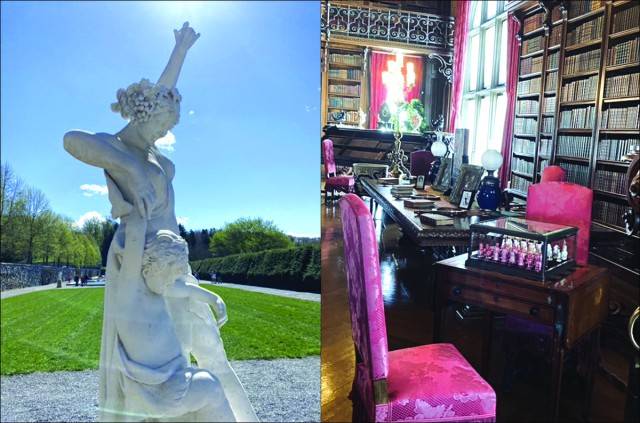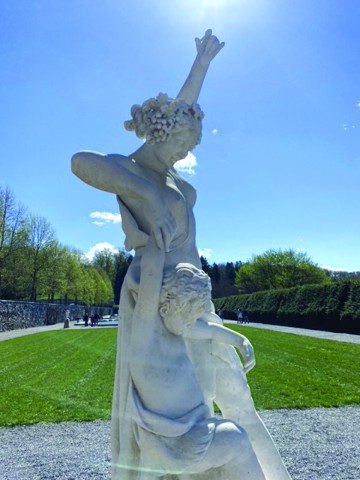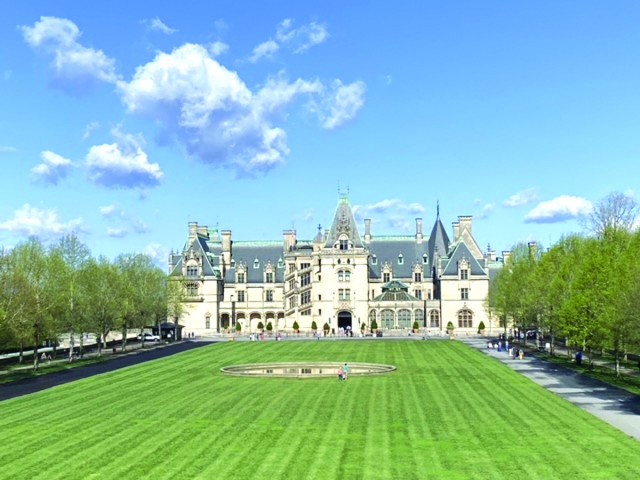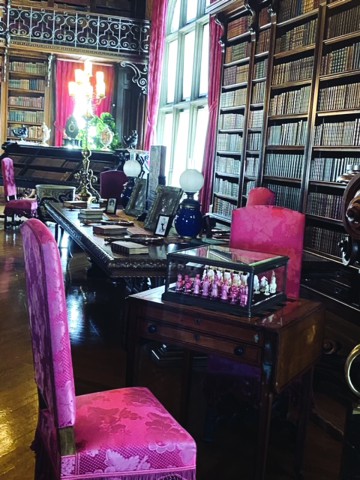
Spring brings forth a sense of renewal and rebirth, a time to reflect on destiny – and on whether one has lived a life well.
In that context, it is always useful to study the lives of others: what constitutes a good life, what values should we live with, what is our one true North or guiding star? As we age, these thoughts preoccupy us more than ever – and what drives us – in terms of meaning, passion and purpose.
Life is never linear. I would never have thought that visiting the largest private house in North America could be such a vivid reminder of what does matter in life – not the vastness of the estate but how one could choose to cultivate time and purpose with imagination and flair.

Biltmore was created by the millionaire George Washington Vanderbilt as a country retreat in Asheville North Carolina – away from the hustling everyday busyness of his life. He invited friends and families to share his life’s passion for the outdoors during the Christmas of 1895.
Biltmore lies in the mountains off the Blue Ridge Parkway. It was modeled after a French chateau with over 250 rooms and 35 bedrooms, 45 bathrooms (10 to spare) as well as impeccably maintained gardens. The approach to the house is through 4 miles of wooded park land until one chances upon a huge house set in 75 acres of more formal gardens.
The work is a wonder of a gilded age, wondrous even now a almost 130 years later. It combines graceful architecture designed by the architect Richard Morris Hunt with arboreal artistry spread over 130,000 acres of land created by the landscapist Frederick Law Olmstead. The Biltmore estate was named Biltmore in homage to Vanderbilt’s Dutch ancestry – ‘Bilt’ as his place of origin combined with ‘Moor’ referring to the open tracts of mountain land.

What struck me the most about this estate was the founder’s commitment to excellence and to his forward thinking. The process was almost as important as the end product. He wanted the finest of things that old money could buy but the land was as important as the house itself. He wanted a house built on an elevation, which had views over the land that he had wandered through in trails in the late 1800s.
Reputedly, Vanderbilt paid scant attention to his investments or family business. He saw Biltmore as his family legacy. He was engaged in many pursuits – classical literature, history, architecture, and gardening. His original two floor library remains intact – with over 10,000 books in many languages. The library overlooks a beautiful balcony or loggia with a view of the Blue Ridge Mountains.

It is easy to dismiss such rich men’s diversions – but from the sense of sustainable farming and gardening that exists even today, one can get a sense of how people even in that era cared about sustainability, environmental practices and how to protect rural life. The first American school of forestry management was established here and through it Vanderbilt sought to create a sustainable paradise that would last beyond his life time.
The idea was to replicate the working estates of Europe which had rental cottages, a community for those engaged in the estate and could contribute to the local economy. Men were taught to read and write on the estate and be trained in various pursuits such as scientific forestry programs - whether poultry, cattle or dairy or programs. Youth were targeted to design and make hand carved furniture, woven baskets and more. The estate remains family owned even to this day, professionally managed and open to visitors. Over a million and a half visit each year.

So why does any of this matter? Ralph Waldo Emerson the writer speaks of the good life well lived: “To laugh often and much, to win the respect of intelligent people and the affection of children, to earn the appreciation of critics and endure the betrayal of false friends, to appreciate beauty. To find the best in others – to leave the world a bit better whether through a healthy child, a garden, to know that even one life breathed easier because you lived. This is to have succeeded.”
By that count, Vanderbilt lived a full life, despite an early death in his fifties – his sense of appreciation for the Blue Ridge Mountain landscape, a single child Cornelia who grew up playing on the estate, a combination of architectural beauty and verdant gardening and a legacy of breathtaking beauty and magnificence.
Very few of us have the means to live on that scale and grandeur. However, one can draw inspiration from his determination to live his life by focusing his time and energy on creative pursuits that would bring happiness to many beyond him. I came away from Biltmore inspired. One hopes to channel some of what one has seen into one’s own life – whether by planting herbs and flowers, or by walking in the open, or simply enjoying beauty created by others which spans generations, centuries and cultures.
In that context, it is always useful to study the lives of others: what constitutes a good life, what values should we live with, what is our one true North or guiding star? As we age, these thoughts preoccupy us more than ever – and what drives us – in terms of meaning, passion and purpose.
Life is never linear. I would never have thought that visiting the largest private house in North America could be such a vivid reminder of what does matter in life – not the vastness of the estate but how one could choose to cultivate time and purpose with imagination and flair.

Biltmore was created by the millionaire George Washington Vanderbilt as a country retreat in Asheville North Carolina – away from the hustling everyday busyness of his life. He invited friends and families to share his life’s passion for the outdoors during the Christmas of 1895.
Biltmore lies in the mountains off the Blue Ridge Parkway. It was modeled after a French chateau with over 250 rooms and 35 bedrooms, 45 bathrooms (10 to spare) as well as impeccably maintained gardens. The approach to the house is through 4 miles of wooded park land until one chances upon a huge house set in 75 acres of more formal gardens.
Very few of us have the means to live on that scale and grandeur. However, one can draw inspiration from his determination to live his life by focusing his time and energy on creative pursuits
The work is a wonder of a gilded age, wondrous even now a almost 130 years later. It combines graceful architecture designed by the architect Richard Morris Hunt with arboreal artistry spread over 130,000 acres of land created by the landscapist Frederick Law Olmstead. The Biltmore estate was named Biltmore in homage to Vanderbilt’s Dutch ancestry – ‘Bilt’ as his place of origin combined with ‘Moor’ referring to the open tracts of mountain land.

What struck me the most about this estate was the founder’s commitment to excellence and to his forward thinking. The process was almost as important as the end product. He wanted the finest of things that old money could buy but the land was as important as the house itself. He wanted a house built on an elevation, which had views over the land that he had wandered through in trails in the late 1800s.
Reputedly, Vanderbilt paid scant attention to his investments or family business. He saw Biltmore as his family legacy. He was engaged in many pursuits – classical literature, history, architecture, and gardening. His original two floor library remains intact – with over 10,000 books in many languages. The library overlooks a beautiful balcony or loggia with a view of the Blue Ridge Mountains.

It is easy to dismiss such rich men’s diversions – but from the sense of sustainable farming and gardening that exists even today, one can get a sense of how people even in that era cared about sustainability, environmental practices and how to protect rural life. The first American school of forestry management was established here and through it Vanderbilt sought to create a sustainable paradise that would last beyond his life time.
The idea was to replicate the working estates of Europe which had rental cottages, a community for those engaged in the estate and could contribute to the local economy. Men were taught to read and write on the estate and be trained in various pursuits such as scientific forestry programs - whether poultry, cattle or dairy or programs. Youth were targeted to design and make hand carved furniture, woven baskets and more. The estate remains family owned even to this day, professionally managed and open to visitors. Over a million and a half visit each year.

So why does any of this matter? Ralph Waldo Emerson the writer speaks of the good life well lived: “To laugh often and much, to win the respect of intelligent people and the affection of children, to earn the appreciation of critics and endure the betrayal of false friends, to appreciate beauty. To find the best in others – to leave the world a bit better whether through a healthy child, a garden, to know that even one life breathed easier because you lived. This is to have succeeded.”
By that count, Vanderbilt lived a full life, despite an early death in his fifties – his sense of appreciation for the Blue Ridge Mountain landscape, a single child Cornelia who grew up playing on the estate, a combination of architectural beauty and verdant gardening and a legacy of breathtaking beauty and magnificence.
Very few of us have the means to live on that scale and grandeur. However, one can draw inspiration from his determination to live his life by focusing his time and energy on creative pursuits that would bring happiness to many beyond him. I came away from Biltmore inspired. One hopes to channel some of what one has seen into one’s own life – whether by planting herbs and flowers, or by walking in the open, or simply enjoying beauty created by others which spans generations, centuries and cultures.

